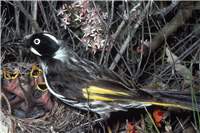Family
Meliphagidae
Genus
Phylidonyris
Species
novaehollandiae
Threats/Control Methods - Regional
Honeyeaters are notorious for spreading exotic weed species as they will feed on these species where they do not have an ample supply of nectar and fruit from native species. Both feral and domestic Cat (Felis catus) attacks threaten this species.
Threats/Control Methods - Local
A reduction in the area of woodland reserves around the suburbs for urban development will impact this species.
Local/Urban Actions
Gardens should be kept free from weeds, as they are easily transported from suburban gardens into nearby native forest areas. Gardeners hoping to attract these birds should plant flowering natives such as grevilleas and banksias in a planned, year-long flowering sequence. Cat owners can consider providing a stimulating indoor or enclosed environment for them to enjoy, without the opportunity to hunt.
Common Names
New Holland Honeyeater, Yellow-winged Honeyeater, Long-billed Honeyeater, White-bearded Honeyeater, White-eyed Honeyeater, Fuschiabird
Distinguishing Features
This bird is mostly black and white, with a distinctive large golden wing panel and yellow edged tail feathers. Its face is striking due to its bright white eyes on a black face patch. The females of the species are slightly smaller and the young are browner with a grey eye.
Survey Techniques
Call and visual identification.
Species Call
Abrupt, metallic and piercing 'tjik! chwik!' and some chattering notes.
Similar Species
The White-cheeked Honeyeater (Phylidonyris nigra) is very similar, except its eye is black instead of white and it has a large white patch on its cheek. The two species regularly occur together.The White-naped Honeyeater (Melithreptus lunatus ) is smaller and has different markings, but could be confused from a distance.
Distribution
This species is found in Australia's southern areas, from Brisbane, QLD to just north of Perth, WA.
Country of Origin
Australia
Conservation (Pet/Pest) Status - Regional
Highest numbers are found in the Australian National Botanic Gardens and along the Murrumbidgee river corridor. Overall, population numbers vary significantly from year to year (COG).
Conservation (Pet/Pest) Status - National
Secure, not listed under the EPBC Act 1999. Numbers appear to be declining in the north or their range.
LSCCES Population
Due to this species love of native shrubs, very high numbers were found at the ANBG. A high number were also found at CSIRO, and lower numbers on the ANU campus and in suburban Turner.
Associated vegetation community
This species is found in greatest numbers in coastal heath. Any forest or woodland with a good native shrub layer is also favourable. Flowering shrubs are common in the urban gardens and therefore can provide a suitable habitat.
Limiting Resources
The New Holland Honeyeaters depend on a good source of high every nectars and fruits, preferably from native plants.
Breeding
The New Holland Honeyeaters build a cup shaped nest of bark and grasses that is bound with spider web. Nests sit in low tree branches or shrubs and the 2-3 fawn speckled eggs need 18 days of incubation. Both parents feed the young for 16 days. In the Canberra region, the exact timing of the nesting season changes from year to year.
Behaviour
This is a bold and noisy bird, producing sharp calls while flying and flashing their yellow feathers. They are also inquisitive and known to readily approach humans.
Functional Group
Food Species
This species actively feeds on nectar from flowering shrubs, particularly Australian native species including grevilleas and banksias. They also need to eat insects and spiders for their protein intake.
Predators
The showy and carefree nature of this species leaves it vulnerable to Cats (Felis catus).
Interesting Fact
This species will breed in any month that nectar plants are in flower, as the adults need the sugary nectar for energy to catch all the insects required to feed the young.
References - (reader suitability of references, P=Primary teachers, S=Secondary students, T=Tertiary students and researchers)
Books:Longmore, W. 1991. Honeyeaters and their Allies of Australia. CollinsAngus & Robertson Publishers Australia. NSW. P, S, T
Morcomber, M. 2000. Field guide to Australian Birds. Steve Parish Publishing, Archerfield. P, S, T
Pizzey, G. 2000. The Graham Pizzey & Frank Knight Field Guide to the Birds of Australia. Angus & Robertson, Sydney. P, S, T
Veerman, P. 2003. Canberra Birds: A report on the first 21 years of the garden bird survey. Philip Veerman and Canberra Ornithologists Group. Canberra. S, T
Internet: Birds in Backyards. 2006. [online]. Available at:http://www.birdsinbackyards.net P, S, T
Canberra Ornithological Group (COG). 2004. Birds of Canberra Gardens. COG and the ACT Department of Urban Services. [online]. Available at:http://garden.canberrabirds.org.au/ P, S, T
Online Publications:Nix, H. and Cunningham, R. 2006. Birds of the Lower Sullivans Creek Catchment, Canberra ACT. Prepared for the Life in the Suburbs project using data from the Lower Sullivans Creek Catchment Ecological Survey (LSCCES). Australian National University. Canberra. [online]. Available at: http://www.lifeinthesuburbs.com.au/category.php?id=65 S, T
Olsen, P. et al. 2005. The State of Australia's Birds 2006: Invasive Species. Supplement to Wingspan 16:4. Birds Australia. [online]. Available at: http://www.birdsaustralia.com.au/soab/SOAB2006.pdf S, T


 Top
Top Top
Top